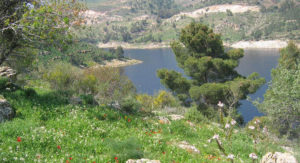Jordan
Jordan is a country situated in the scope of Med-O-Med program, geographical and culturally. That is why and with the objective to use them as reference for the different research and catalogues created by the program, that we present this data for the country in different subjects.
MAIN PHYTOGENETIC RESOURCES OF JORDAN AND THE MAIN THREATS
The country’s singular geography has led to the generation of a rich diversity of subspecies, and even of some local endemic species. The Gulf of Aqaba has great biological diversity, with 50% of its coast being bordered by coral, with more than 192 scleractinia and 120 soft coral species, as well as 268 known species of fish (with estimates of up to 1,000 fish species).
Some of the country’s most characteristics plants (some of which are endemic) are: Iris petrana, Cousinia dayia, Plantago maris-mortui, Crucianella transjordanica, Scrophularia nababeorum, Silene hussonii y Tamarix arvensis, Colchicum tunicatum, Euclidium syriacum, Lathyrus gloeospermus, Bruñera orientalis, Hetrocaryum szovitsianum Onosma roussaei, Campanula heirosoymtana, Legousia falcata, Silene hussonii, Chardinia orientalis, Centaurea procurrens, Cnicus benedicuts, Convolvulus schimprei, Aethionema carneum, Matthiola Arábica, Cupressus semprevirens, Equisetum ramosissimum, Aegilops bicornis, A. cylindrica, A. ovata, A. distachyos, Asthenatherum forsskalii, Cutandia maritima y C. philistaea, Festuca arundinaceae, Hyparrhenia hirta, Pinnisetum asperifolium, P. ciliare, P.divisum, Taeniatherum crinitum, Terapogon villosus, Ajuga iva, Teucrium leucocladum, Astragalus annularis, A. Sanctus, Hippocripis bicontorta, Midicago litoralis, Teragonolobus requienii, Trigonella maritima, Plantago marismortui, etc.
However, many of these populations are at risk because of excessive harvesting and grazing. Some of the endangered species are trees such as Ceratonia siliqua, shrubs such as Astragalus, Cistus and Salvia, bulbs such as tulips, orchids, iris and other genera such as Artemisia, Achilla, Salvia, Paroniquia, Ecballium, Efedra, Ajuga, Marrubium, Origanum, Alcea, Thymus, Sarcopoterium, Hyoscyamus, etc.
STATUS OF IN-SITU AND EX-SITU CONSERVATION
Today there are 35 protected areas in Jordan, including a marine reserve, covering 10.9% of the total territory. Over the last decade, Jordan has drawn up a number of environmental policies and strategies relating to biodiversity and the management of natural resources.
The latest are the National Strategy for Biodiversity (2003) and the National Agenda (2005). The number of reserves and their total size is a key indicator for achieving the 2010 goal. 6 new reserves have been planned, with the national goal being to rise from 10.9% to 12% of protected areas by 2010 and 15% by 2017.
The 54 specific actions laid down in the National Strategy include: evaluation of the status of species and drafting of the Red Paper on species at risk of extinction; establishment of a national centre for conservation and sharing of germplasm; establishment of a herbarium for algae and fungi; identification, conservation and management of water plants and relict species, especially on sand dunes, the Dead Sea and the river Jordan.
With the aim of bringing together all these actions, a proposal has been made to create the Jordanian Royal Botanic Garden which would not only be a botanic garden but would also coordinate and develop research programmes on wild and cultivated biodiversity, conservation programmes, extension and rural development all over the country.
Centers of Plant Diversity

 Jordan is in the Middle East and has no coast except for 28 kilometres at the tip of the Gulf of Aqaba. Most of the country (80%) is arid or semi-arid, with a desert plateau to the west and a high plateau in the east. The lowest point of Jordan (and of any land surface in the world) is 416 metres below sea level, in the Dead Sea. Only 4% of the land is arable and less than 1% is covered with trees.
Jordan is in the Middle East and has no coast except for 28 kilometres at the tip of the Gulf of Aqaba. Most of the country (80%) is arid or semi-arid, with a desert plateau to the west and a high plateau in the east. The lowest point of Jordan (and of any land surface in the world) is 416 metres below sea level, in the Dead Sea. Only 4% of the land is arable and less than 1% is covered with trees.
Natural resources (water, oil, gas) are scarce. In spite of these difficult conditions and partly because of its unusual geographical position between three continents, its diverse topography and considerable climatic variations, Jordan has a disproportionate abundance of life forms considering the small habitat area.
Four bio-geographical regions can be found in Jordan – the Mediterranean, the Riano-Turnan region, the Arab-Sahara region and the tropical region.
Jordan is a country situated in the scope of Med-O-Med program, geographical and culturally. That is why and with the objective to use them as reference for the different research and catalogues created by the program, that we present this data for the country in different subjects. This post is available in: English Español

